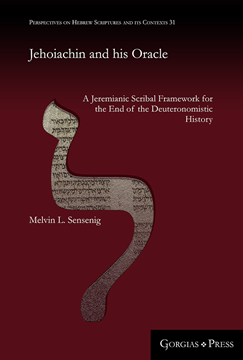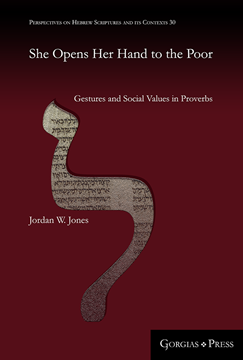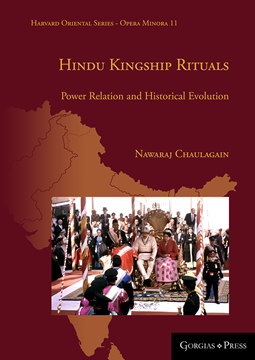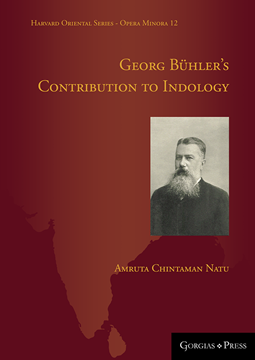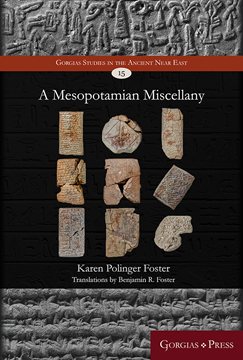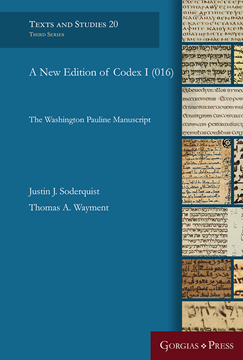Jehoiachin and his Oracle
A Jeremianic Scribal Framework for the End of the Deuteronomistic History
ISBN: 978-1-4632-4043-1
King Jehoiachin, the last Judahite king exiled to Babylon, became the focus of conflicting hopes and fears about a revived Davidic kingship after the exile. As Sensenig demonstrates, this conflict stemmed from a drastic oracle from Jeremiah that seemed to categorically reject Jehoiachin, while the canon records that he not only survived but thrived in exile.
$114.95 (USD)
She Opens Her Hand to the Poor
Gestures and Social Values in Proverbs
ISBN: 978-1-4632-4045-5
While scholarship on nonverbal communication in the Hebrew Bible has traditionally focused on ritual dress, postures of worship, and related topics, there exist a number of non-ritual gestures in the text for which we have little understanding, such as occur in the book of Proverbs. As the premier source for moral pedagogy in the Hebrew Bible, Proverbs contains a number of gestures that, when properly interpreted, enhance an understanding of social values in ancient Israel. To aid in the process of decoding these literary features, Jones examines Ugaritic, Akkadian, Egyptian, and Sumerian texts, identifying similar gestures and anatomical idioms and how they are variously interpreted in their respective contexts. Though the particular religious and cultural systems of these neighboring entities are distinct, their ideology of social values—values imbedded in the fabric of daily life and indicative of the universally shared experience of all communities—comes to the fore through the medium of gesture.
$114.95 (USD)
Hindu Kingship Rituals
Power Relation and Historical Evolution
Series: Harvard Oriental Series - Opera Minora 11
ISBN: 978-1-4632-4047-9
In recent decades, Nepal has witnessed a dramatic shift from its ancient form of Hindu kingship to a federal republican democratic secular order, with the official dissolution of monarchy in 2008. This study deals with the religious lives of the Śāh kings of Nepal, concentrating on such major rituals as the “coronation” (rājyābhiṣeka) and the autumnal navarātri (Goddess-centered) festival. This study unravels how religion and politics were deeply intertwined in the ritual activities, and how the rituals, in their traditional deeply religious and devotional settings, exerted a maximum of socio-political powers for the king and his institutions.
$98.00 (USD)
Georg Bühler's Contribution to Indology
Series: Harvard Oriental Series - Opera Minora 12
ISBN: 978-1-4632-4049-3
This book deals with the life and pioneering work of Georg Bühler in the various fields of Indology. It argues that Bühler's interactions with the 19th c. India influenced his approach as a researcher and in turn his methodology which then followed his self-developed path of Ethno-Indology. The work is a result of study for the doctoral degree of the Savitribai Phule Pune University, Pune, India. Along with source materials available in India, the author consulted those in Germany and Austria.
$114.95 (USD)
A Mesopotamian Miscellany
By Karen Polinger Foster; Translation by Benjamin R. Foster
Series: Gorgias Studies in the Ancient Near East 15
ISBN: 978-1-4632-4052-3
Drawn from Akkadian and Sumerian tablets in the Yale Babylonian Collection, many of them previously unpublished, this collection of readings brings to life the vibrancy of ancient Mesopotamian literature, beyond its better-known myths and epics.
$65.00 (USD) $52.00 (USD)
A New Edition of Codex I (016)
The Washington Pauline Manuscript
Series: Texts and Studies (Third Series) 20
ISBN: 978-1-4632-4054-7
Nearly a century has passed since Henry A. Sanders first published his editio princeps of the Washington Manuscript of the Epistles of Paul (Codex I or GA 016). Within that time, it has received very little scholarly attention. This new edition provides a fresh, conservative transcription based on two new image sets.
$149.50 (USD)
